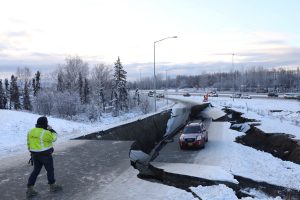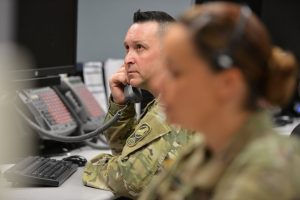
By Yereth Rosen
ANCHORAGE, Alaska (Reuters) – A powerful earthquake shook southern Alaska on Friday morning, buckling roads, disrupting traffic and knocking television stations off the air in the state’s largest city, but there were no immediate reports of injuries.
The 7.0 magnitude earthquake’s epicenter was 8.1 miles (13 km) north of Anchorage, home to about 40 percent of the state’s population. The temblor had a depth of 26.7 miles (43 km), the U.S. Geological Survey said.
A tsunami warning was issued for Cook Inlet, which links Anchorage with the Gulf of Alaska, but it was later canceled.

Earthquake damage is seen inside a store in Anchorage, Alaska, U.S. November 30, 2018 in this image obtained from social media. David Harper/via REUTERS
The quake, of a magnitude that is common in Alaska, was followed by numerous aftershocks, and climatologist Rick Thoman reported that he felt it in Fairbanks, about 350 miles north of Anchorage, a city of about 300,000 residents.
“Thought the house was going to come apart,” Anchorage-based climatologist Brian Brettschneider wrote on Twitter, posting a picture of his kitchen floor scattered with items that had fallen from cupboards.
Anchorage suffered major infrastructure damage, police said in a Twitter message, with homes and buildings damaged, and many roads and bridges are closed.
Rush-hour traffic in Anchorage came to a standstill and jammed up heading out of town after the quake struck at around 8:30 a.m. local time (1230 EST/1730 GMT).
Governor Bill Walker said he had issued a disaster declaration and was in direct contact with the White House, which said President Donald Trump was monitoring the situation.
The state has had an average of one magnitude 7 to 8 earthquake every year since 1900, according to the state government website, and the state has more earthquakes than any other U.S. region. Southern Alaska experienced the second largest earthquake ever recorded in 1964, which had a magnitude of 9.2.
Video posted on social media showed supermarkets with items from shelves strewn across the floors in the quake’s aftermath and of television station KTVA’s newsroom in shambles.
A photo posted by a reporter at KTVA showed a deserted showroom, with part of its ceiling collapsed and debris scattered throughout the room. CNN reported that television station KTUU, an NBC affiliate, also was knocked off the air.

A stranded vehicle lies on a collapsed roadway near the airport after an earthquake in Anchorage, Alaska, U.S. November 30, 2018. REUTERS/Nathaniel Wilder
KTUU’s website featured a photo of a snow-covered highway that had buckled, with a car sitting between two deep fissures crossing the highway.
The Ted Stevens Anchorage International Airport remained open, but arrivals and departure ramps were closed and there were reports of road damage, the airport said on Twitter.
The city’s schools were evacuated and parents were notified to pick up their children.
(Additional reporting by Gabriella Borter in New York; Writing by Peter Szekely in New York; Editing by Chizu Nomiyama)









